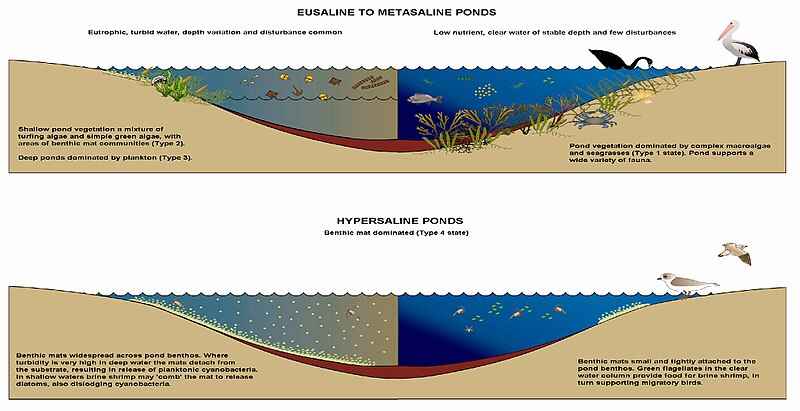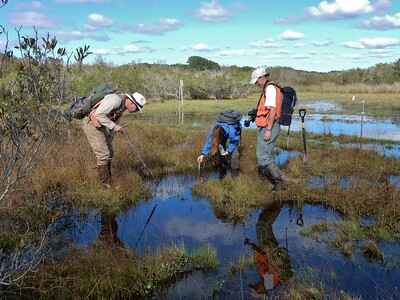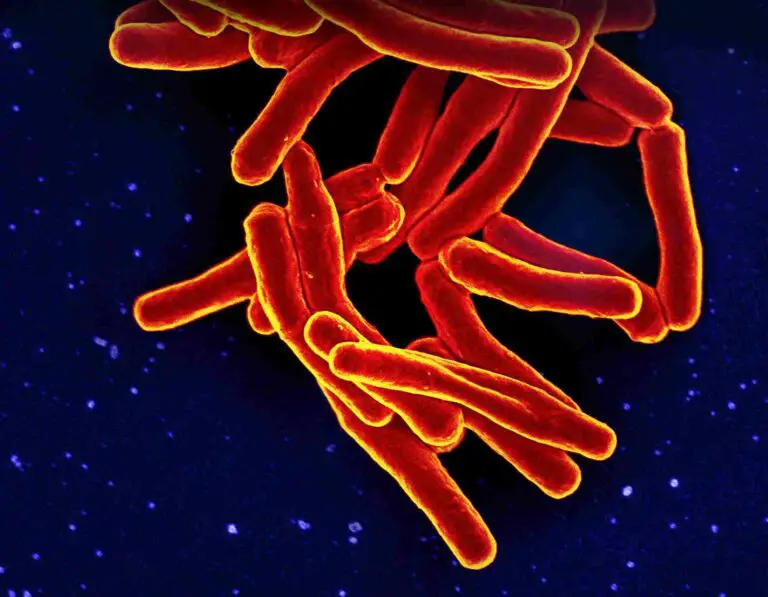Pond Vs Lake Comparison With Multiple (5) Criteria
Pond vs lake comparison can be made using areal coverage, vertical extent, biological productivity, zonation, and water composition, to identify similarities and differences between the two lentic ecosystems.
This article discusses similarities and differences between ponds and lakes based on multiple criteria, as follows;
1). Areal Coverage (as a Criteria in Pond Vs Lake Comparison)
It must first be acknowledged that both ponds and lakes are enclosed aquatic ecosystems, with lentic (non-flowing) characteristics [3], and can hardly be differentiated in real-life, on the basis of any criteria at all.
However, ideally, ponds are smaller water bodies than lakes; both in terms of areal coverage, and in depth or vertical extent.
The areal size of a lake is at least 5 acres or 20,234 square meters, and can extend to tens of acres.
Caspian Sea on the Eurasian continental border is known to be the largest lake in the world, measuring up to 3.7 × 10^11 square meters in area.
The volume of water in a lake ranges from several thousands to several million gallons, depending on both area and depth.
For ponds on the other hand, they are ideally associated with an average areal coverage or size of less than 150 square meters, making them much smaller than ponds.

2). Vertical Extent
To measure the depth of a pond, it is usually necessary to take various readings of the vertical extent from surface to bottom at various (ideally, regular) intervals from one end of the water body to an opposite end. The values derived may then be summed and averaged to get the depth of the water body.
In addition to being larger in size or areal coverage, lakes have a greater vertical extent, or depth, than ponds.
Many lentic water bodies described as ponds, have depth not exceeding 6 meters. On the other hand, lakes can have depths of over several tens of meters.
The deepest part of lakes and ponds is called the benthic zone, end-zone, or last-drop; which indicates that the water body has reached its maximum depth at this point.
In clear lakes with less undissolved-suspended solids and low turbidity, solar radiation can reach significant depths, whereas muddy lakes with high amounts of suspended solids may have shallower depth of solar penetration.
The best depth for a lake is one which allows it to contain significant volume of water, as well as biodiversity, while allowing solar radiation to penetrate across a significant portion of the overall vertical extent.
Because ponds are associated with smaller size and shallower depth [7], they are more exposed to solar radiation across their entire vertical extent.
Depth, area and solar penetration all affect other definitive attributes of lakes and ponds including their biological productivity, which is discussed in the following section of this article.
3). Biological Productivity (as a Criteria in Pond Vs Lake Comparison)
Biological productivity in lakes is a measure of the ability of the lake as an ecosystem, to support the reproduction, metabolism and survival of aquatic organisms.
For both lakes and ponds, biological productivity is ultimately traceable to autotrophic organisms at the lowest level (Primary Producers; Level 1) of the food chain or energy pyramid, which are able to manufacture their own food by photosynthesis..
Because these organisms introduce bioenergy into the ecosystem that is used by all organisms; the biological productivity of lakes and ponds is always proportional to primary productivity.
The primary productivity of lakes and ponds is the rate of photosynthetic production of biomass and bioenergy by autotrophs like algae and aquatic plants.
Among all aquatic ecosystems, the most biologically-productive is arguably coral reefs, which are a microbiome under marine aquatic systems. The reason for this is that coral reefs have a high primary productivity level [6], owing to a huge and diverse population of photosynthetic organisms that live symbiotically on the carbonate framework of reefs.
With regards to the comparison between ponds and lakes, biological productivity is higher in lakes when it is measured on an overall, summary basis. However, the biological productivity per unit area and depth of ponds can be higher than that of lakes.
The reason for this is differences in the penetration of solar radiation in both aquatic ecosystems.
For lakes that are relatively shallow and clear (few insoluble suspended particles) the photic zone which receives visible light from the Sun is large, while the aphotic zone with less solar penetration is relatively narrow. This increases primary production for such lakes [4].
On the other hand, lakes with significant depth and muddy, turbid water may have a very narrow photic zone as electromagnetic waves from the Sun are obstructed, deflected and absorbed by the suspended particles before they can reach any notable depth. This is why such lakes have low biological productivity per unit volume.
By being shallower, ponds on the other hand are more likely to receive solar radiation across a greater extent of their depth and area, so that their productivity per unit volume is relatively high.
Both ponds and lakes play host to a similar group of organisms, most of which are adapted to freshwater. These range from algae and vascular aquatic plants to amphibians, fish, and crustaceans.
Crustaceans tend to occur more in ponds and lakes that contain saline water, than in freshwater bodies [2].
The biomass pyramid in lakes and ponds is often inverted [5], because consumers tend to be several times larger than the producers.
Parameters used to evaluate the biological productivity of ponds and lakes include species richness, population size, species number, total dry-biomass, and biodiversity.

4). Zonation
The zonation of water bodies is simply the occurrence of notable variations in physicochemical and biological characteristics from one segment, area, or zone to another.
Four (4) zones of a lake are littoral, limnetic, profundal and benthic zones.
The littoral zone comprises of the land and shallow-water area surrounding the lake [8], and terminates where the land meets the water surface. All land area within a lentic environment, that is influenced by the water body (pond or lake), falls under the littoral zone.
Limnetic zone of lakes and ponds is the open surface of the water body, where it is most exposed to the atmosphere and solar radiation. This zone is important because it is responsible for the entry of solar energy that is used by all aquatic organisms.
Profundal zone follows directly after the limnetic zone, and usually extends from the near-surface to the point from which physical, chemical and biological conditions are not optimal to support organic life. Many organisms in lakes and ponds navigate between the near-surface and the lower extreme of the profundal zone.
The benthic zone is the lowest segment of the vertical profile of a lake or pond. It comprises of the sedimentary bottom of the water body, and the narrow segment of water close to the bottom.
Organisms occurring in the benthic zone are bottom-dwellers, which are able to survive under aphotic conditions. In lakes, many bottom dwellers feed on biomass that descends to the bottom as remnants of metabolic processes occurring in overlying zones.
Lakes and ponds are different in their zonation; where lakes tend to have more distinct and numerous zones than ponds.
Because they are generally shallower, ponds do not always represent multiple zones across their vertical profile. For example, some ponds comprise of only littoral and limentic zones, with no well-developed benthic zone.
Solar radiation can also permeate all zones in a shallow pond, making it difficult to distinguish between different vertical segments based on light penetration (photic and aphotic).
Lakes on the other hand, tend to have a well-developed vertical profile, with identifiable differences that can be used to distinguish at least three different segments from each other.
Because lakes and ponds are lentic water bodies, there is limited water flow, meaning that the vertical profile of these water bodies can be stratified or zoned, even across a relatively shallow depth. This is why the limnetic, profundal, benthic, photic and aphotic zones of a lake or pond are much narrower than those of a stream or ocean.
5). Water Composition (as a Criteria in Pond Vs Lake Comparison)
Ponds and lakes can also be compared based on the water composition of each.
The composition of pond water includes gases (like oxygen and carbon dioxide) organic matter, soluble salts, minerals, and insoluble suspended solids.
Major components of lake water are minerals, dissolved salts, suspended particles, metals, and gases.
While both are essentially identical in composition, lakes are more likely to have a diverse range of water components than ponds, due to their larger volume.
The possibility of saline water conditions is also higher for lakes, because they are more likely to be linked to larger marine water bodies by small tributaries under the surface.
Lakes and ponds with fewer constituents and moderate nutrient levels have better water quality for organic survival [1].

Conclusion
Pond vs lake comparison can be carried out based on areal coverage, vertical extent, biological productivity, zonation, and water composition, as summarized in the table below;
Comparison Criteria | Pond | Lake |
Areal Coverage | Ideally less than 150 m^2 on average | May exceed 20,000 m^2 |
Vertical Extent | Rarely exceeds 6 m depth | May far exceed 6 m |
Biological Productivity | Higher productivity per unit area Lower overall productivity | Lower productivity per unit area Higher overall productivity |
Zonation | Vertical stratification Less-defined zones | Vertical Stratification Better-defined zones |
Water Composition | Lower saline tendency Lower diversity Higher concentration | Higher saline tendency, Higher diversity Lower concentration |
References
1). Bhateria, B.; Jain, D. (2016). "Water quality assessment of lake water: A review." Springer, Sustainable Water Resources Management 2(2). Available at: https://doi.org/10.1007/s40899-015-0014-7. (Accessed 22 April 2023).
2). Boix, D.; Gascón, S.; Sala, J.; Badosa, A.; Brucet, S.; López-Flores, R.; Martinoy, R. M.; Gifre, J.; Quintana, X. D. (2010). "Patterns of composition and species richness of crustaceans and aquatic insects along environmental gradients in Mediterranean water bodies." Hydrobiologia 597(1):53-69. Available at: https://doi.org/10.1007/978-90-481-9088-1_6. (Accessed 21 April 2023).
3). Christofoletti, C. A.; Correia, J. E.; Marinho, J. F. U.; de Souza, C. P.; Guedes, T.; Ansoar, Y.; Claudia, A.; Marcato, C.; Fontanetti, C. S. (2015). "Lentic habitats as study models for assessing aquatic contamination." Advances in Environmental Research (pp.87-108). Available at: https://www.researchgate.net/publication/271133003_Lentic_habitats_as_study_models_for_assessing_aquatic_contamination. (Accessed 22 April 2023).
4). Hoverman, J. T.; Johnson, P. T. J. (2012). "Ponds and Lakes: A Journey Through the Life Aquatic." Nature Education Knowledge 3(6):17. Available at: https://www.nature.com/scitable/knowledge/library/ponds-and-lakes-a-journey-through-the-25982495/. (Accessed 21 April 2023).
5). Keva, O.; Taipale,.S. J.; Hayden, B.; Thomas, S. M.; Vesterinen, J.; Kankaala, P.; Kahilainen, K. K. (2021). "Increasing temperature and productivity change biomass, trophic pyramids and community-level omega-3 fatty acid content in subarctic lake food webs." Glob Chang Biol. 2021 Jan;27(2):282-296. Available at: https://doi.org/10.1111/gcb.15387. (Accessed 22 April 2023).
6). Lange, I. D.; Noguera, C. S.; Roth, F.; Cortés, J.; Rixen, T.; Wild, C. (2015). "Upwelling Increases Net Primary Production of Corals and Reef-Wide Gross Primary Production Along the Pacific Coast of Costa Rica." Frontiers in Marine Science 2. Available at: https://doi.org/10.3389/fmars.2015.00113. (Accessed 22 April 2023).
7). Richardson, D. C.; Holgerson, M. A.; Farragher, M. J.; Hoffman, K. K.; King, K. B. S.; Alfonso, M. B.; Andersen, M. R.; Cheruveil, K. S.; Coleman, K. A.; Farruggia, M. J.; Fernandez, R. L.; Hondula, K. L.; López Moreira Mazacotte, G. A.; Paul, K.; Peierls, B. L.; Rabaey, J. S.; Sadro, S.; Sánchez, M. L.; Smyth, R. L.; Sweetman, J. N. (2022). "A functional definition to distinguish ponds from lakes and wetlands." Sci Rep. 2022 Jun 21;12(1):10472. Available at: https://doi.org/10.1038/s41598-022-14569-0. (Accessed 21 April 2023).
8). Zohary, T.; Gasith, A. (2014). "The Littoral Zone." Aquatic Ecology 6:517-532. Available at: https://doi.org/10.1007/978-94-017-8944-8_29. (Accessed 22 April 2023).



